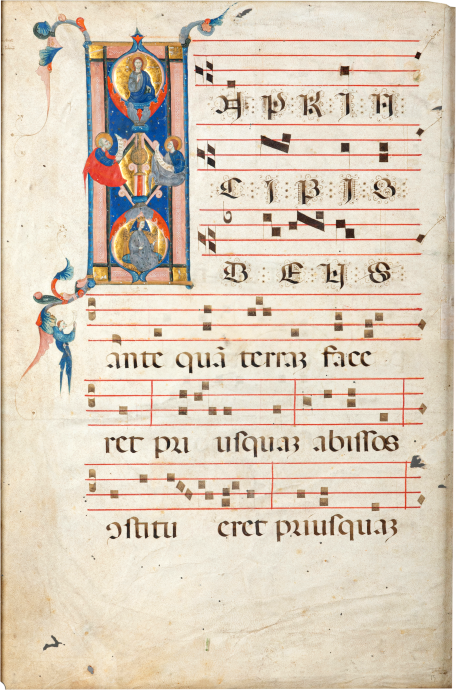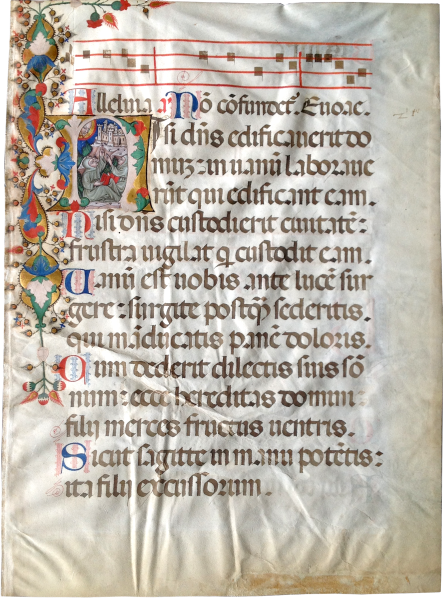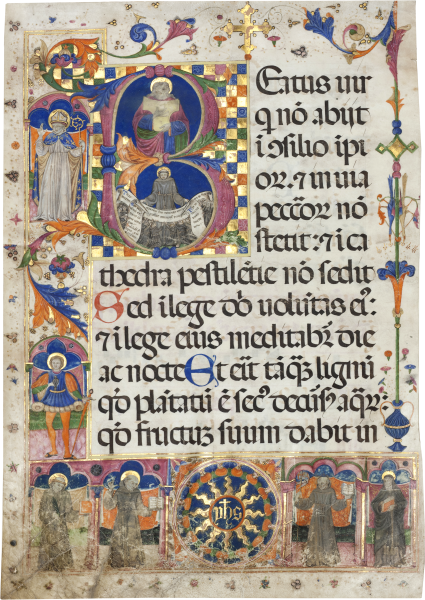


Neri da Rimini

Neri da Rimini
Description
This remarkable leaf is signed and painted by Neri da Rimini, one of the finest miniaturists of fourteenth-century Italy and an enthusiastic assimilator of Giotto's expressive style. It is one of fifty-some known leaves that trace to a set of Choir Books executed by Neri and his workshop for the Dominican Monastery of Saint James the Apostle in Forlì. This leaf is exceptional, however, as the only signed miniature by Neri from this group.
Neri da Rimini was the leader of a flourishing workshop from around 1300 to 1338 when he is last documented as “Nerius miniator notarius” in a register of notaries in Rimini. Much of his career is recorded through his willingness to sign his work as seen here in the present miniature. Neri and his workshop illuminated the Choir Books for Saint James between 1310–1314, a fascinating period in which his style transitioned from the archaizing overtones of late thirteenth century Bolognese illumination into more modern volumetric sensibility that followed in the wake of Giotto. His work in the present leaf straddles these two genres while simultaneously pursuing new heights of linear elegance.
This miniature is certainly one of the finest of the fifty some sister leaves presently dispersed throughout public and private collections in Europe and the United States (e.g. figs. 1–2). These likely relate to eight volumes illuminated by Neri, now in the Biblioteca Comunale “Aurelio Saffi” in Bologna, which are missing numerous leaves. While Gaudenz Freuler (2013) has proposed a tentative grouping, a formal reconstruction remains lacking and exact correspondences between the folios and the Choir Books are unknown. Leaves from this series, however, can be identified by idiosyncrasies found nowhere else in Neri’s oeuvre (see Nicolini and Lollini 2004, 104–109). These include the placement of a small letter ‘M’ at the end of each stave line to signal the height of the first note of the next line and the distinctive use of chrysography for the incipits of the chants, both of which are found in the present leaf.
The historiated initial ‘I’ is decorated with the figures of Christ at the top, the prophet Sirach and a youthful Solomon flanking the middle, and a seated King Solomon at the base. The iconography can be partially verified by an inscription to the illuminator, trimmed through in the upper left corner, which reads “…in Maestate dei…in Solomonis cattedra.” The initial is set against a deep blue background, recalling a celestial sky, and enclosed by a bright pink frame mounted with white fillagree. Three acanthus vines sprout from the corners of the frame and extend into the margins, the bottommost bearing a drollery in a blue cloak blowing a horn. A second smaller and badly rubbed miniature in an initial ‘O’ inhabits the verso, depicting a seated, crowned figure likely also representing King Solomon.
The chant provides the response to the so-called Summer Histories from Wisdom sung on the first Sunday of August. The passage juxtaposes Solomon and Sirach, who each authored books dedicated to the subject. Beginning “In principio Deus antequam terram faceret, priusquam abyssos constitueret, priusquam…” (in the beginning, before God created the earth, before he formed the abyss, before…), the response refers to the eighth chapter of Solomon’s Proverbs, which entails the origin of Wisdom before the creation of the world. The text on the recto (the true verso of the leaf) “Omnis sapientia a Domino Deo est et cum illo fuit semper et est ante aevum” (All wisdom is from the Lord God and has been with him always and is before eternity) concludes the first chapter in Sirach’s Ecclesiasticus.
Neri’s signature, discovered by Freuler, is shrewdly inserted into the banderols held by Sirach and Solomon at the center, integrating the painter’s aesthetic intelligence into the broader theme of Wisdom. From left to right, the inscription reads: “opus nerio miniatore de arimino hoc.” The signature does not necessarily confirm Neri’s direct authorship of the miniature, as Massimo Medica (2016) has pointed out, for the artist often signed pieces from his workshop as a form of certification. Here, however, the ostentatious placement of the signature as well as the highly professional execution of the miniature make it likely that Neri was indeed the painter. This extraordinary intervention executed at the center of the lavish initial make this leaf an exceptionally rare example of Neri’s work and documents an important moment in the history of miniature painting in fourteenth-century Italy.
We are grateful to Gaudenz Freuler for expertise.
Bibliography
Unpublished. For further reading see:
Emiliani, Andrea, ed. Neri da Rimini: Il Trecento riminese tra pittura e scrittura, Milan, 1995.
Freuler, Gaudenz. Italian Miniatures from the Twelfth to the Sixteenth Century, 2 vols. Cinisello Balsamo, 2013, vol. I, pp. 214–227.
Freuler, Gaudenz, and Georgi Radomirov Parpulov. The McCarthy Collection, volume I: Italian and Byzantine Miniatures, London, 2013, pp. 132–135, no. 41.
Hindman, Sandra, and Federica Toniolo, eds. The Burke Collection of Italian Miniature Paintings, London, 2020, pp. 286–295, no. 28.
Martoni, Alessandro, Federica Toniolo, and Massimo Medica. Le miniature della Fondazione Giorgio Cini: Pagine, ritagli, manoscritti, Cinisello Balsamo, 2016, p. 252.
Nicolini, Simonetta and Fabrizio Lollini. “I corali miniati della biblioteca ‘A. Saffi’ di Forlì: Vicende e problem,” Studi Romagnoli 52 (2004), pp. 104–128.
Palladino, Pia, ed. Treasures of a Lost Art: Italian Manuscript Painting of the Middle Ages and Renaissance. New York, 2003, pp. 15–19, no. 5.

